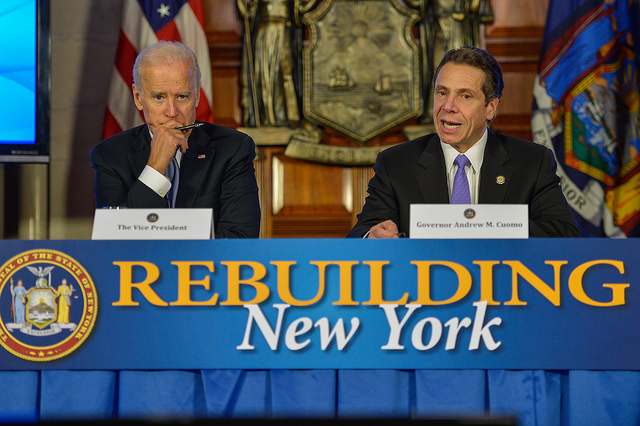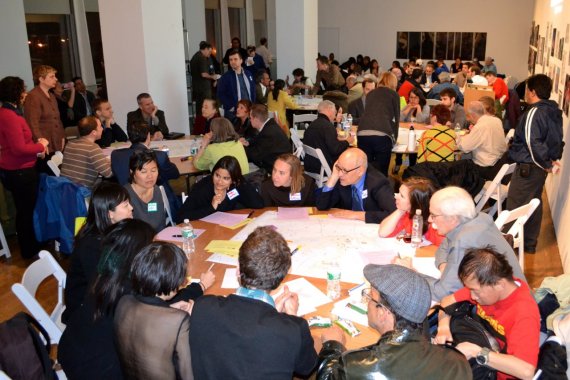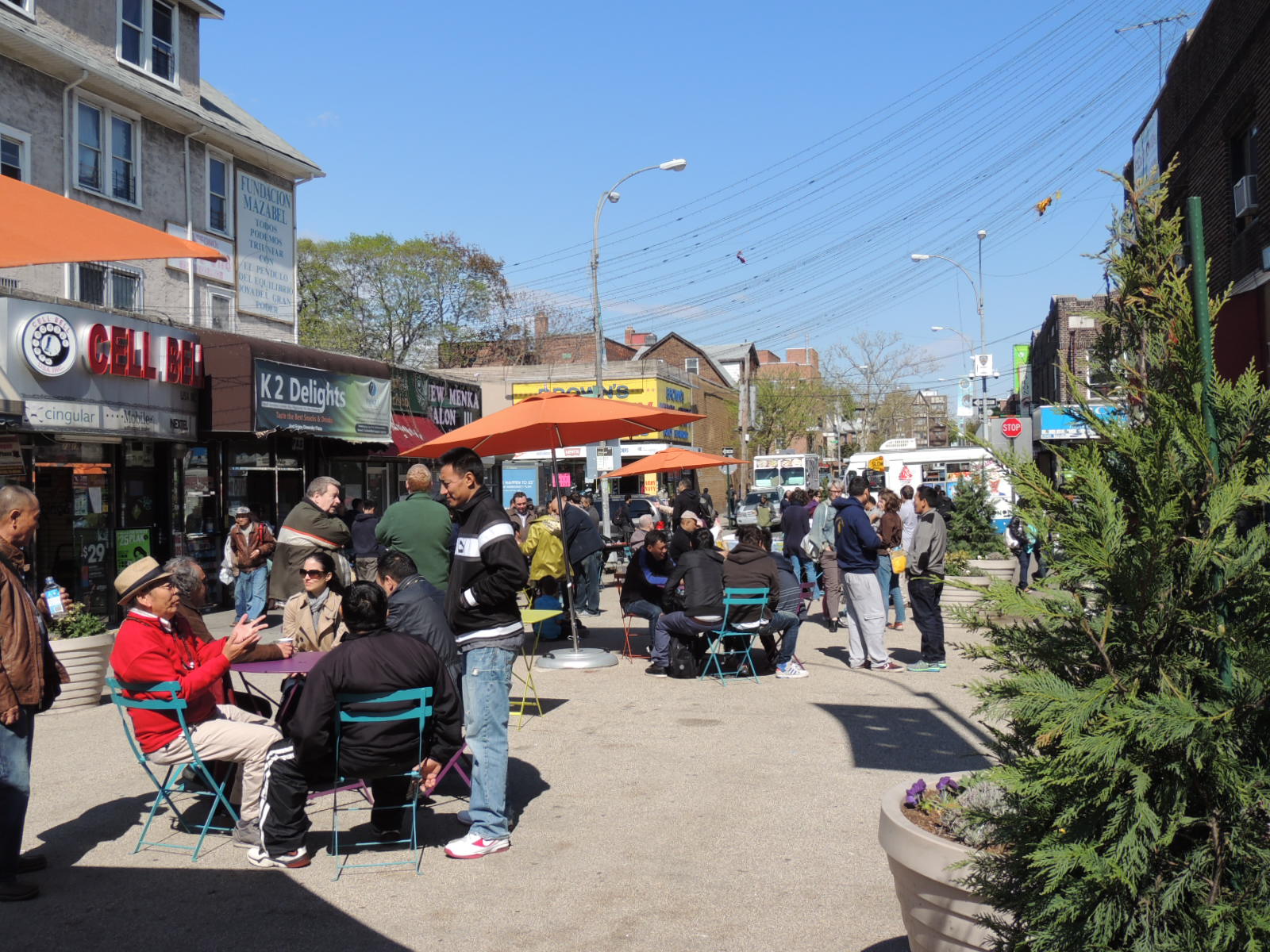In Defense of Plazas, from Times Square to Brownsville
Diversity Plaza in Jackson Heights, Queens (@NPPNYC)
Police Commissioner Bratton's suggestion to remove the Times Square plazas in order to rid them of desnudas is not just about the future of one of the world's best public spaces. This regressive response could undermine a policy that has transformed New York's public realm.
Pedestrian plazas are an inexpensive, effective way to advance Mayor de Blasio's agenda for a more equitable city, addressing the essential tenets of his admirable OneNYC Plan. They improve public safety, promote health and wellness, cultivate arts and culture, create new open space (30 acres so far), and generate economic activity. Miles away from the crowds on 42nd Street, dozens of New York City neighborhoods have embraced their plazas and the civic benefits they deliver.
For every aggressive Elmo at Times Square there are a dozen children playing hide-and-seek among plaza planters in Corona; yoga classes in Brownsville; families reading together in Ozone Park; thousands of immigrants celebrating holidays in Jackson Heights; and the regulars playing chess in Clinton Hill.
More than 70 neighborhood plazas give people much-needed places to relax, meet with friends, eat lunch, or simply find a seat. Nearly half of those plazas are located in the city's densest neighborhoods, where parks and spaces for community events are scarce.
These plazas, including those at Times Square, are inherently different from both the pedestrian malls of the 1970s and the "privately owned public spaces" made possible by a 1961 zoning amendment and which proliferated in Manhattan in the 1980s and '90s.
The Department of Transportation (DOT) Plaza Program is consciously designed to address the challenges posed by those earlier models, by giving local organizations management responsibility. These new plazas reclaim streets for and with community input. Local non-profits take on the responsibility of managing the plazas, from programming to keep the space active to full-on maintenance. This gives them a decidedly community character, reflected in each plaza's daily rhythms and formal events.
New York's neighborhood plazas are the 21st century expression of Jane Jacobs' "sidewalk ballet," now playing out in streets reclaimed by citizen activists.
It is telling to remember that in 2009 when the DOT took the radical step of closing swaths of Broadway to vehicles, there was much hue and cry about the ruin of Times Square. That spring the streets were painted closed, and as a stop-gap measure while furniture was on order, the Times Square Alliance bought 600 lawn chairs and put them on the street. Two things happened right away: droves of people sat in them; and the lawn chair became a new symbol of Times Squares - loved and hated in equal measure.
There was pent-up demand for this kind of space, and the public conversation went straight to what kind of chairs the plaza should have, drowning out the debate over whether or not the street should be closed to cars. Now, seven years later, this backlash against the mayor's considered solution to the desnudas is clear: New Yorkers and tourists alike love their plazas.
Neighborhood plazas, especially those in high-need areas, are facing their own quality of life challenges, as well as significant financial stress in managing their upkeep. The Times Square controversy has ignited a long-overdue public conversation about our collective vision for public space and the equity issues it raises.
These problems are solvable. They simply require some new thinking about how to manage a new asset. We owe it to every neighborhood, and to the millions of New Yorkers enjoying this network of urban commons, to address these issues without undermining one of the city's most progressive amenities.
***
by City Council Members Daniel Dromm and Brad Lander, and Laura Hansen, Managing Director, Neighborhood Plaza Partnership/The Horticultural Society of New York
Dromm is the New York City Council Member, District 25, home to Diversity Plaza
Lander is the New York City Council Member, District 39, home to Kensington Plaza
Laura Hansen is Managing Director, Neighborhood Plaza Partnership/The Horticultural Society of New York
Hudson River Rail Tunnel Discussions Recall Checkered History of Federal Aid to New York

Gov. Cuomo & VP Biden (photo via the governor's office on flickr)
New Jersey officials met with U.S. Secretary of Transportation Anthony Foxx on August 18 to discuss strategies for building new rail tunnels under the Hudson River between New Jersey and New York. The existing tunnels, over a century old, were damaged by Superstorm Sandy in 2012 and recently experienced electrical failures and train delays.
Governor Andrew Cuomo has been pressuring the federal government to pay what he refers to as "the lion's share" of the costs for the new tunnels. It isn't clear whether Cuomo wasn't invited or chose not to attend the August 18 meeting. He had told reporters a week earlier that any meeting would be premature until Washington committed to a sizeable investment in the project. "There's no reason to meet now," he said snappishly. "They need to put their money where their mouth is."
After the meeting, the heated rhetoric cooled a bit. In a statement on August 19, Cuomo hailed the meeting as a step in the right direction but reiterated "I strongly support the construction of the new Hudson River tunnel – and a federal grant package that makes the project viable is an essential first step." A spokesman for Secretary Foxx responded that "As the governor knows, the federal government doesn't just issue grants without a fully defined scope, project, and applicant and at the present time there isn't a fully defined project or applicant we can even grant money to."
We can hope that the tone of the dialogue will continue to get more positive and New York, New Jersey, and federal officials will get down to concrete negotiations. The need is critical and, as Cuomo has pointed out, there have been many inconclusive meetings over the years to address it.
But looking back through history, federal aid to big New York projects has been an inconsistent story.
In the early 19th century, New York sought federal aid to build a cross-state canal. A delegation of New Yorkers lobbying Congress in 1812 found little support and noted resentment that "the envied state of New York" was "a supplicant for the favor and a dependent on the generosity of" the federal government rather than using its own resources. Five years later, partial funding was included in a bill that passed Congress, only to be vetoed by President James Madison. He found no authorization in the Constitution for federal support for "watercourses," the president said. Canal advocate DeWitt Clinton, the Mayor of New York City, described the veto message as "a miserable sophism...reprehensible conduct" motivated by sectional rivalry and "jealousy of the growing prosperity of New York."
A resentful New York stopped asking for U.S. assistance. Clinton was elected governor in 1817, and the state built the Erie Canal with its own resources.
In 1975, New York City was on the verge of bankruptcy due to overspending, financial mismanagement, and banks' unwillingness to provide additional loans to the city. Gov. Hugh Carey established the Municipal Assistance Corporation and an Emergency Financial Control Board to oversee the city's budget and provide investors with assurance that funds lent to the city would be repaid.
To obtain additional needed funding, the city sought a federal guarantee of its securities. President Gerald Ford, who was critical of the city's profligate spending, refused to consider what he termed a "bailout." That led to a now-famous New York Daily News headline on Oct. 30, 1975: "FORD TO CITY: DROP DEAD."
Ford did not actually utter those words but he believed his stern position would help force New York City to mend its fiscal management. An indignant Carey complained in a speech a few days later that "it isn't fair when the President of the United States hauls off and kicks the people of the City of New York in the groin." But the next year, as state oversight and city budget reductions began to improve the situation, Ford declared that New York had "bailed out itself." He agreed to federal loans to the city.
Carey learned from the process. In 1979, when the state was desperately seeking resources to aid in the cleanup of the Love Canal area in Niagara Falls, the governor persuaded president Carter to declare the area a federal disaster area, which freed up modest federal resources. The next year, a confidential study of the toxic site by the federal Environmental Protection Agency was leaked to the New York Times. It reported alarming evidence of cancer and chromosome damage. Hooker Chemical, which had dumped toxic chemicals in the abandoned canal, covered them over, and then sold the land to unsuspecting purchasers, was the main culprit. At about the same time as the EPA study, though, reports surfaced that the Army had dumped chemicals at the site during World War II. The Defense department denied it, but it provided just a whiff of federal culpability.
Carey saw an opportunity: use the report to renew pressure on the federal government to pay for relocation of residents who were panicked by the EPA report's alarmist message. "Permanent relocation away from the contaminated area is the only reasonable way to deal with the trauma being experienced by area residents," he told the press. It was a neat political pivot, directing attention away from the state's response to the crisis and toward President Jimmy Carter.
Politics played in New York's favor. Carter, running for reelection in 1980 and trailing challenger Ronald Reagan, needed the Empire State's votes. In October of that year, he flew to Niagara Falls to sign legislation authorizing massive federal aid to supplement state resources to relocate residents and contain the toxic chemicals. (Carter carried Niagara County in the election but lost New York and the election to Reagan.)
The projected price tag for the Hudson tunnel work -- $14 billion -- is itself evidence of the need for federal help. New York officials are on something of a roll, having secured federal aid for the cleanup after Sandy and assistance in the construction of the new Tappan Zee bridge. This time, New Jersey will be an ally and a partner, and it can be argued that the tunnels are critical corridors in the nation's transportation infrastructure.
History suggests, however, that politics and perception are always factors when it comes to federal assistance to New York. Arguably the nation's historically most significant state, and given to assertive self-confidence, New York is often regarded by outsiders as being able to take care of itself. Usually, it can. But other times -- and the Hudson River tunnel is a good example -- we can legitimately ask for federal assistance.
***
Dr. Bruce W. Dearstyne is the author of the book The Spirit of New York: Defining Events in the Empire State's History, published in 2015 by SUNY Press.
***
Have an op-ed idea or submission for Gotham Gazette? E-mail editor Ben Max: This email address is being protected from spambots. You need JavaScript enabled to view it.
Put Queens Residents First in Willets Point Development

FC Queens community meeting
For decades, the Willets Point area in Queens has loomed large in the daydreams of real estate developers and city planners. Redevelopment plans for this neighborhood of mechanic shops and other small businesses have been floated for decades, but none have come to fruition.
Now that the city has all but abandoned a fatally flawed Bloomberg-era plan for the area, a new plan for cleaning up Willets Point is still needed, but it must better address the needs of the low-income and working-class Queens community in which it's located. There are several specific ways in which this goal must be realized.
Several years ago, the Bloomberg administration made a deal with Related Companies and Sterling Equities to redevelop Willets Point to yield the developers enormous profits, but with little commitment to build affordable housing. But a court ruled against the development, because it would have unlawfully allowed a shopping mall to be built upon part of Flushing Meadows-Corona Park.
Mayor de Blasio's administration recently decided not to join the developer in appealing a judge's decision to ban the mall's construction without real concessions from the developer toward meeting the community's needs through affordable housing development.
As the Fairness Coalition of Queens (FC Queens) has been arguing for years now, the last thing that Queens needs is another mall. What the Queens residents in the area do need, and deserve, is the following.
First and foremost, Willets Point needs to be cleaned up. The site has been highly contaminated for more than a century. Now that the city has spent millions displacing dozens of vibrant small businesses from the area, it's at least time to remove the toxins from our communities' backyard.
Second, as affordable housing becomes ever more scarce in Queens, it's vital that Willets Point be used to build truly affordable housing—with a substantial proportion of units that are affordable to the many local residents earning 20 to 30 percent of Area Median Income.
Third, with jobs so hard to come by for local Queens residents, the Willets Point development must ensure that local residents are granted hiring preferences, with strong training and apprenticeship programs to provide career pathways for local workers.
Fourth, whoever ultimately develops Willets Point should be required to contribute significantly to the Flushing Meadows-Corona Park Conservancy and be partners in improving the park to better serve Queens residents.
Finally, the community must be deeply involved throughout the planning process. FC Queens, an umbrella group of dozens of faith, immigrant, housing, and youth-serving agencies, has been at the forefront of preserving open space and expanding affordable housing. The administration and its chosen developers need to engage our stakeholders in this process to ensure that the next plan for Willets Point is one that actually works for Queens residents.
We all want a bright, new future for Willets Point, but it must be a plan that puts the needs of Queens residents first. Otherwise, the history of failed development plans for this prized Queens site will continue to repeat itself.
***
Javier H. Valdés is the Co-Executive Director of Make the Road New York, the largest grassroots community organization in New York offering services and organizing the immigrant community, and a member of the Fairness Coalition of Queens. On Twitter: @maketheroadny.
***
Have an op-ed idea or submission for Gotham Gazette? E-mail editor Ben Max: This email address is being protected from spambots. You need JavaScript enabled to view it.





